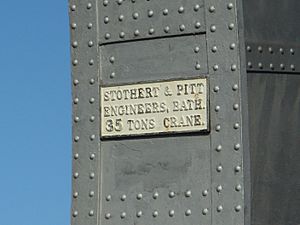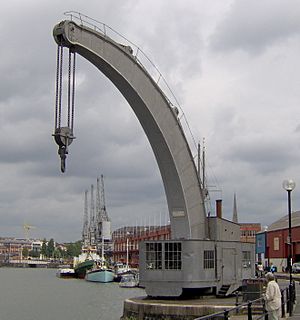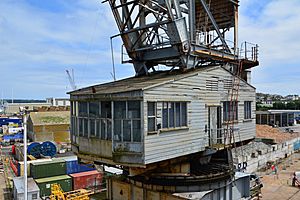- This page was last modified on 17 October 2025, at 10:18. Suggest an edit.
Stothert & Pitt facts for kids
Stothert & Pitt was a British engineering company. It started in 1855 in Bath, England. The company built many different things, from large cranes for docks to machines used in construction and even household items made of cast iron. Stothert & Pitt stopped doing business in 1989. Its name and ideas are now part of another company called Clarke Chapman.
Contents
How Stothert & Pitt Started
George Stothert moved to Bath in 1785. He took over an ironmonger's business, which sold metal goods. George was an agent for the Coalbrookdale Iron Company, selling all kinds of iron items for homes. By 1815, they opened their own foundry, a place where metal is melted and shaped. This was because the Coalbrookdale company opened its own store nearby. George's son, also named George, then managed the company. In 1851, they showed a hand-operated crane at the Great Exhibition.
In 1837, Henry Stothert, who was the younger George's brother, started an ironworks in Bristol. First, it was called Henry Stothert & Co.. Later, Edward Slaughter joined, and it became Stothert, Slaughter & Co. This company built big iron structures. These included a bridge that could turn over the River Frome. They also made some of the first engines for famous railways like Brunel's Great Western Railway.
Robert Pitt started learning his trade with Stothert in Bath in 1834. He worked there until 1840. From 1840 to 1841, he was a draughtsman (someone who draws plans) for Stothert, Slaughter & Co. in Bristol. He came back to Bath in 1841 to help set up Stothert's Newark Street Foundry. In 1844, Pitt became a partner in the company. Another partner named Rayno also joined. The company was often just called Stotherts. In 1855, it officially became Stothert and Pitt. It became a limited company in 1883 and again in 1902.
From the 1840s to 1900, the company in Bath grew very quickly. They moved to bigger places, first to Newark Street Works, then to Victoria Works in the 1890s. These works filled the valley between the river and the Lower Bristol Road. You can still see some early work by Stothert on the Kennett & Avon Canal in Bath. Two nice iron bridges there have the Stothert name on them. But it was in the 1840s that the company started making the cranes that would make them famous worldwide.
The oldest crane that might have been made by Stothert is in Carmarthen and dates from about 1850. It does not have a name plate. The oldest crane with the Stothert & Pitt name was used in Box quarries. It is probably from the 1860s. This crane was made to lift 6 tons. It was in a garden in Box until it was fixed up and brought back to the Newark Works in June 2023. The company became well-known for building large cranes in 1869. They made a huge Titan crane to set 27-ton blocks for building a breakwater in Karachi.
They then built a 35-ton Fairbairn steam crane for Bristol docks in 1876. This crane used an improved design by William Fairbairn. In 1876, they also sent a crane for setting blocks to Colombo Harbour Works in Ceylon.
The 20th Century
Stothert & Pitt built cranes for railways that were sent to different parts of the British Empire.
Electric Dock Cranes
Stothert and Pitt supplied their first electric crane to Southampton Dock Authority in 1892. Electric power had many good points. Powerful motors could be put in each crane and powered from a central place. This meant each crane did not need its own steam engine and boiler. The crane parts were also lighter. This allowed them to be placed on raised frames that could go over a railway track. This type of crane is called a portal crane. Now, the railway could go right to the edge of the dock. Cranes were also ready to use right away, without waiting for boilers to heat up steam. Most importantly, electric cranes could move along the dock edge on their own railway lines. Ships did not have to wait for a single spot next to a fixed crane. Instead, cranes could be moved to each ship's cargo areas as needed. This made one crane much more efficient, meaning it could handle more cargo each day. Soon, these mobile electric cranes were used almost everywhere.
Five electric cranes made in 1951 are still kept by Bristol Museum Service at Princes Wharf.
Level-Luffing Cranes
In 1912, Stothert & Pitt's design team created a better way for cranes to lift loads. This was called level-luffing gear. It made handling cargo much faster and more efficient. This system used special cables to automatically keep the hook, and whatever it was lifting, level. This happened even as the crane's arm (jib) moved up and down.
Bulk Handling Cranes
As cranes became more common and ships got bigger, cranes also became more specialized. In 1927, Stothert & Pitt made the first bulk-handling crane. Instead of a simple hook for many types of loads, this crane was designed to use a special grab. This grab could pick up loose materials like coal. The first one was used to unload coal at a power station in London.
Another new idea was the kangaroo crane. Instead of the crane turning to reach a hopper (a container for dumping materials) on shore, a kangaroo crane has its own hopper built under its arm. This hopper turns with the arm. Dumping the grab's contents into the hopper now only needs the faster up-and-down movement of the arm, without needing to turn the whole crane.
World War I Efforts
In July 1915, the company started building the Pedrail Machine. This was an early attempt to create an armoured fighting vehicle for use in World War I. The machine was designed to move across rough ground. It was meant to carry troops safely across the dangerous "no-man's-land" between trenches. The War Office later decided to finish it as a mobile flame-thrower. The completed frame was given to the Trench Warfare Department in August, but no more work was done on it.
World War II Efforts
During World War II, Stothert & Pitt built tanks and miniature submarines for the War Office. They also made other weapons.
The Challenger tank was an improved version of the Cromwell tank. It was designed to carry a more powerful 17 Pounder gun. Stothert & Pitt built this tank and made several changes to its design. They also built the A30 (Avenger) tank destroyer, which had the same powerful gun on a similar tank frame.
After the Wars
By 1974, Stothert & Pitt had built 30,000 single-drum rollers that people walked behind.
What Happened Next
The company was sold to Robert Maxwell's Hollis Group in 1986. After Maxwell's business empire failed, the company's managers tried to buy it in 1988. But this did not work, and the company closed in 1989. All its factories shut down. The Stothert & Pitt name was sold to Langley Holdings, which is now part of the NEI group, owners of Clarke Chapman. Today, the name is used for advice on dock cranes. Even though they no longer make things, the company still exists for advice, information, and repairs.
Stothert & Pitt moved from Bath to Bristol in 2008. They moved again in 2019 to Keynsham. Stothert & Pitt still offers spare parts and support for all its dockside and offshore cranes that are still working.
Former Factory Sites
Stothert & Pitt's old Newark Works, which is now a grade II listed building (meaning it's protected for its history), was turned into flexible workspaces for small businesses in 2022. This was part of the Bath Quays development. Their larger site was developed into homes starting in 2011. Newark Works now works as a "creative hub" for new local businesses and technology companies.
What Stothert & Pitt Made
Construction Machines
- Pedestrian rollers (machines that flatten roads)
- Vibroll 28W Roller
- Concrete mixers (machines that mix concrete)
- "Victoria" mobile mixers
- Lorry-mounted concrete mixers (concrete mixers on trucks)
- Concrete batching plants (factories that mix concrete)
- "Super 64" concrete mixer – used for building airport runways
- No.16 Tarmacadam plant for the War Office (a machine for making road material)
- Cranes
- Goliath type yard cranes (very large cranes)
- "Titan", a 50-ton block-setting crane built in 1899 for building breakwaters (walls to protect harbors) at South Shields.
Other Products
- Dock cranes
- Container loaders from the 1970s (for loading shipping containers)
- Goliath cranes for dock building
- Electric dock cranes (some are still kept at Bristol docks and 12 are protected in Royal Victoria Dock in London)
- DD2 Dock cranes, in different sizes (5 tons at 80 feet, 5 tons at 100 feet, or 3 tons at 65 feet)
- Shipyard cranes
- Hammerhead cranes for Rosyth Dockyard, able to lift up to 120 tons or reach 180 feet, built in 1965.
- And for HMNB Devonport in Plymouth, a crane with 1,450 tonnes of structure that could lift 80 tonnes. This one was recently taken apart.
- Fire grates & household ironmongery (metal items for homes, like fireplace grates)
- Offshore platform cranes (made until the factories closed)
- Pump units (now made by Albany Pumps)
- Railway breakdown cranes (used to clear train accidents in the early 1900s)
- Ship cranes
- Seaplane recovery cranes, for the Admiralty (used to lift seaplanes from the water)
- Scissor lifts (self-propelled platforms that lift straight up), introduced in the 1980s
- Winches (machines for pulling or lifting with ropes or cables)
- Lifeboat davits (structures used to lower and raise lifeboats), like the ones on the HMHS Britannic
See also
- Aveling-Barford
- Joseph Day
- Clarke Chapman
- Northern Engineering Industries Ltd – (NEI)
- Albany Pumps





